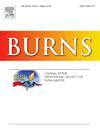Recovery in patients undergoing ablative fractional carbon dioxide laser for adult hypertrophic burn scars: A longitudinal cohort study
IF 3.2
3区 医学
Q2 CRITICAL CARE MEDICINE
引用次数: 0
Abstract
Introduction
Ablative fractional carbon dioxide laser (AFCO2L) is widely used as a treatment for hypertrophic burn scars. This study aimed to evaluate clinician and patient-reported outcomes after AFCO2L treatment, safety, and identify factors influencing outcomes.
Methods
This longitudinal study recruited adult patients with hypertrophic burn scars treated with AFCO2L at a single Australian burn unit. Patients received up to four AFCO2L treatments over approximately 12 months. Outcomes were ultrasound scar thickness, the Patient and Observer Scar Assessment Scale (POSAS), and the Brisbane Burn Scar Impact Scale (BBSIP), measured at baseline and 3, 6, and 12 months after the first AFCO2L treatment. Analysis used mixed effects linear models.
Results
47 patients were included with median age 32 years (IQR: 24, 53) and median burn TBSA of 35 % (IQR: 7.5 %, 48 %). Statistically significant improvements between baseline and 12-month follow-up occurred in scar thickness, and all POSAS and BBSIP subscores. Most improvements remained when accounting for TBSA, Fitzpatrick skin type, scar maturity, and body area treated. Patients reported transient symptoms after 61 of 89 (69 %) AFCO2L treatments, but infection or delayed wound healing occurred after only 4 of 89 (4 %) treatments.
Conclusion
This study supports safety and improved clinician and patient-reported outcomes in patients undergoing AFCO2L for hypertrophic burn scars.
接受二氧化碳点阵消融激光治疗成人增生性烧伤疤痕患者的恢复情况:纵向队列研究。
简介消融点阵二氧化碳激光(AFCO2L)被广泛用于治疗增生性烧伤疤痕。本研究旨在评估AFCO2L治疗后临床医生和患者报告的疗效、安全性,并确定影响疗效的因素:这项纵向研究招募了在澳大利亚一家烧伤科接受 AFCO2L 治疗的成年增生性烧伤疤痕患者。患者在大约 12 个月的时间内接受了最多四次 AFCO2L 治疗。研究结果包括超声疤痕厚度、患者和观察者疤痕评估量表(POSAS)以及布里斯班烧伤疤痕影响量表(BBSIP),分别在基线和首次 AFCO2L 治疗后 3、6 和 12 个月进行测量。分析采用混合效应线性模型:47名患者的中位年龄为32岁(IQR:24岁至53岁),中位烧伤总面积为35%(IQR:7.5%至48%)。从基线到 12 个月随访期间,疤痕厚度、所有 POSAS 和 BBSIP 子分数均有明显改善。在考虑到总热辐射面积、菲茨帕特里克皮肤类型、疤痕成熟度和治疗面积的情况下,大部分改善仍然存在。在 89 次 AFCO2L 治疗中,有 61 次(69%)治疗后患者出现短暂症状,但 89 次治疗中仅有 4 次(4%)治疗后出现感染或伤口延迟愈合:本研究支持对肥厚性烧伤疤痕患者进行 AFCO2L 治疗的安全性,并改善了临床医生和患者报告的治疗效果。
本文章由计算机程序翻译,如有差异,请以英文原文为准。
求助全文
约1分钟内获得全文
求助全文
来源期刊

Burns
医学-皮肤病学
CiteScore
4.50
自引率
18.50%
发文量
304
审稿时长
72 days
期刊介绍:
Burns aims to foster the exchange of information among all engaged in preventing and treating the effects of burns. The journal focuses on clinical, scientific and social aspects of these injuries and covers the prevention of the injury, the epidemiology of such injuries and all aspects of treatment including development of new techniques and technologies and verification of existing ones. Regular features include clinical and scientific papers, state of the art reviews and descriptions of burn-care in practice.
Topics covered by Burns include: the effects of smoke on man and animals, their tissues and cells; the responses to and treatment of patients and animals with chemical injuries to the skin; the biological and clinical effects of cold injuries; surgical techniques which are, or may be relevant to the treatment of burned patients during the acute or reconstructive phase following injury; well controlled laboratory studies of the effectiveness of anti-microbial agents on infection and new materials on scarring and healing; inflammatory responses to injury, effectiveness of related agents and other compounds used to modify the physiological and cellular responses to the injury; experimental studies of burns and the outcome of burn wound healing; regenerative medicine concerning the skin.
 求助内容:
求助内容: 应助结果提醒方式:
应助结果提醒方式:


